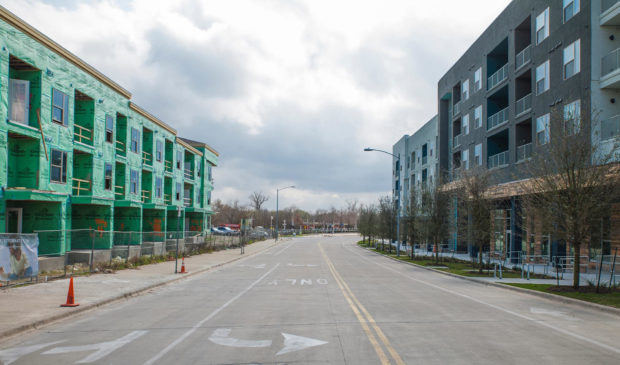135,000 new housing units over the next decade: feasible or overly ambitious?
Tuesday, April 4, 2017 by
Audrey McGlinchy, KUT Socar Chatmon-Thomas points at an apartment building under construction along the south shore of Lady Bird Lake, near East Riverside Drive.
“So this whole thing used to just be nothing,” said Chatmon-Thomas, who has worked in Austin real estate since 1994. “Just fields and that’s it. Nobody lived around here.”
And those who did, said Chatmon-Thomas, paid next to nothing for an apartment. Nearly three years ago, a friend paid $500 a month for an apartment in the area, she said.
Now they start at around $1,000 a month for a one-bedroom, she said.
Chatmon-Thomas recently testified in front of the city’s Planning Commission in support of the city of Austin’s first-ever Strategic Housing Plan. The public will have a chance to weigh in on the plan Thursday. For the first time, the city has set a numerical goal for new housing units – 135,000 units over the next decade. It’s an ambitious goal, said city staff.
“I think it’s an ambitious goal,” Chatmon-Thomas said. But, she said, she believes it can be done if the city offers incentives for developers to include affordable housing in new projects.
Calculating 135,000
To get that 135,000 number, city staff multiplied the units of housing Austin had in 2015 (397,637) by the growth rate for the Austin-Round Rock region, which includes parts of Bastrop, Caldwell, Hays and Williamson counties, for the next decade (34 percent).
But if this is a housing goal only for the city of Austin, why include the growth rate of the larger metropolitan area?
“We had heard through our housing market study that there are people who would like to live in the city of Austin if they could, but because they can’t afford to, they have to live in surrounding areas,” said Erica Leak, who works for the city’s Neighborhood Housing and Community Development Department.
An earlier version of the city’s housing plan set that goal at 75,000 new housing units over the next 10 years. But Leak said public feedback forced them to reconsider that number.
According to a 2014 analysis of the city’s housing market, 60 percent of people who work in Austin commute from outside the city limits.
Within the 135,000 number, the city has set a goal of building 60,000 units affordable for households making roughly $62,000 a year or less. According to Leak, currently the city only has the tools to build fewer than 10,000 affordable units over the next decade. To get the remaining 50,000 will require policy changes – including, for example, a tweaking of the city’s density bonus program, which asks developers to build a certain number of affordable units in exchange for looser zoning regulations.
Is 135,000 the right number?
University of Texas professor Jake Wegmann tends to the hyperbolic when asked about the feasibility of the city building 135,000 units over the next decade.
“To even achieve what the plan lays out would be an incredible, Herculean undertaking that no other large American city’s been able to pull off,” said Wegmann.
He points to the city’s estimated funding – $11.8 billion – needed to fill the gap of affordable housing for those making $25,000 a year or less. Plus, said Wegmann, building this number of units doesn’t only require buy-in from City Council, but also from residents citywide.
In Mayor Steve Adler’s 2017 State of the City address, he emphasized that only certain parts of the city would need to bear the burden of the housing growth. He called this his “Austin Bargain.”
“For starters, let’s agree we will not force density in the middle of neighborhoods,” said Adler. “There’s no sense in shoving density where it would ruin the character of the city we’re trying to save in the first place, where it’s not wanted by its neighbors and where we would never get enough of the additional housing supply we need anyway.”
But Wegmann said that asking most, if not all, of Austin’s neighborhoods to accept new housing would be necessary to meeting this goal.
“If we care about affordability as much as we claim that we do, then this is something we should be doing,” said Wegmann. “But we’re not doing it.”
Others feel the goal of building 135,000 new housing units over the next decade is not ambitious enough.
“Over the last few years, we’ve been building 10,000 to 12,000 units a year,” said Planning Commissioner Chito Vela. According to city data, in 2014 the city permitted 11,004 new housing units. In 2013, that number was closer to 12,000. City staff, though, argue that each decade the city’s housing suffers a downturn – for example, in 2010, the city permitted fewer than 3,000 units, which will lower this decade’s average.
“Just based on our current new home, new apartment, construction combined with population growth over the next 10 years, I think it’s very likely that we will build 135,000 units over the next decade,” said Vela. “I feel like we’re just legislating the status quo.”
Photo by Pavel Mezihorak for KUT News. This story was produced as part of the Austin Monitor’s reporting partnership with KUT.
The Austin Monitor’s work is made possible by donations from the community. Though our reporting covers donors from time to time, we are careful to keep business and editorial efforts separate while maintaining transparency. A complete list of donors is available here, and our code of ethics is explained here.
You're a community leader
And we’re honored you look to us for serious, in-depth news. You know a strong community needs local and dedicated watchdog reporting. We’re here for you and that won’t change. Now will you take the powerful next step and support our nonprofit news organization?









